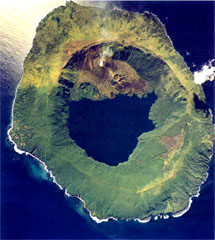Report on Tofua (Tonga) — 8 May-14 May 2024
Smithsonian Institution / US Geological Survey
Weekly Volcanic Activity Report, 8 May-14 May 2024
Managing Editor: Sally Sennert.
Please cite this report as:
Global Volcanism Program, 2024. Report on Tofua (Tonga) (Sennert, S, ed.). Weekly Volcanic Activity Report, 8 May-14 May 2024. Smithsonian Institution and US Geological Survey.
Tofua
Tonga
19.75°S, 175.07°W; summit elev. 515 m
All times are local (unless otherwise noted)
Tonga Geological Services reported that unrest at Tofua continued during 8-14 May. Thermal anomalies were detected daily and had intensities that fluctuated at low levels. The Aviation Color Code remained at Yellow (the second lowest color on a four-color scale); the Maritime Alert Level remained at Orange (the second highest level on a four-color scale) and mariners were advised to stay 2 km away from the island; the Alert level for residents of Vava’u and Ha’apai remained at Green (the lowest color on a four-color scale).
Geological Summary. The low, forested Tofua Island in the central part of the Tonga Islands group is the emergent summit of a large stratovolcano that was seen in eruption by Captain Cook in 1774. The summit contains a 5-km-wide caldera whose walls drop steeply about 500 m. Three post-caldera cones were constructed at the northern end of a cold fresh-water caldera lake, whose surface lies only 30 m above sea level. The easternmost cone has three craters and produced young basaltic-andesite lava flows, some of which traveled into the caldera lake. The largest and northernmost of the cones, Lofia, has a steep-sided crater that is 70 m wide and 120 m deep and has been the source of historical eruptions, first reported in the 18th century. The fumarolically active crater of Lofia has a flat floor formed by a ponded lava flow.

